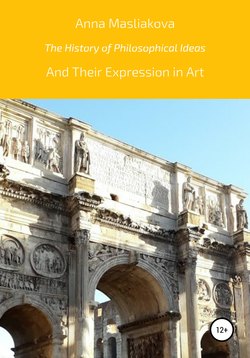The History of Philosophical Ideas and Their Expression in Art

Реклама. ООО «ЛитРес», ИНН: 7719571260.
Оглавление
Анна Ивановна Маслякова. The History of Philosophical Ideas and Their Expression in Art
Introduction
The Healing Power of Art
The Big History of Art
Musical and Aesthetic Concept of Alexander Scriabin
There is No Place Like Rome
Chapter I
Literary Essay I
Philosophical Issues I
Dialog of Arts I
Temples of Culture I
How to Understand a Work of Art? Step I
Chapter II
Once Upon a Time
Literary Essay II
Philosophical Issues II
Dialog of Arts II
Back to the Future
Temples of Culture II
The Cats
Chapter III
Dream, and They Might Come True
Literary Essay III
Philosophical Issues III
Temples of Culture III
Dialog of Arts III
Chapter IV
In Search of Lost Time
Literary Essay IV
Philosophical Issues IV
Dialog of Arts IV
Temples of Culture IV
The Snow Queen
Chapter V
Pride and Prejudice
Literary Essay V
Philosophical Issues V
Dialog of Arts V
Temples of Culture V
How to Understand a Work of Art? Step II
Chapter VI
It Is a Small World
Philosophical Issues VI
Literary Essay VI
Dialog of Arts VI
Temples of Culture VI
Swan Lake
Chapter VII
I Did It My Way
Literary Essay VII
More Than a Language
Dialog of Arts VII
Ars Longa, Vita Brevis
Temples of Culture VII
Reunion
How to Understand a Work of Art? Step III
Conclusion
Archeology of Art
Literature
Отрывок из книги
It is generally accepted that there are Turning Points in our lives that Change Us Forever. So, let me tell you My Story.
I remember my mother sitting at the piano and playing the “Swan Lake”. It was then that I decided to become a Musician. I had no fear of performing in front of the audience and I could play the piano without even looking at the keyboard.
.....
As we have mentioned before, the Romans adopted Greek inventions and developed them on a much larger scale. In Ancient Roman Villas – country houses of nobility rectangular in their shape – they combined Perystilium (a garden surrounded by columns reminding of the Medieval Cloister) and Atrium (the most important part where the guests were greeted) complemented by Compluvium (a square roof opening) and Impluvium (a pool for rainwater). Villas in Pompeii were richly decorated with frescoes of different styles – creating the illusion of marble or panoramic view (like “a window”), emphasizing the flatness of the wall with figures “floating” on it or reintroducing architecture and jumbling together fragments of buildings – and all of them can be seen at the House of Vettii.
And yet, there was a tendency in Roman Philosophy towards individualism and agnosticism (Stoicism, Epicureanism, Skepticism). People were more interested in entertainments, such as Gladiatorial Fights, execution of Christians at the Colosseum and Nero’s singing. It is said that Nero ordered to burn Rome in order to clear the space for his new palace – Domus Aurea designed by Fabulus. It was embellished with gold and decorated with Grotesques which inspired Raphael to create his Loggias in Vatican (and we also have their copies at the Hermitage Museum in Saint Petersburg). After the Emperor’s death the Golden House was filled with earth and built over (Flavian Amphitheater, Baths of Trajan, etc.). By the way, the plan of the Trajan’s Forum reminds of the embracing arms of the Bernini Colonnade, while the structure of Caldarium – a special room with hot water pool at the Roman Baths which had a dome with an opening or oculus – calls to mind the Octagonal Room in the Domus Aurea and the Pantheon. Surprisingly enough, there even was an Ancient Roman Baroque Style, in other words, architects used traditional vocabulary in a different way including too ornate decoration, projections, recessions and broken pediments in their projects (for example, the Market Gate of Miletus in Berlin).
.....